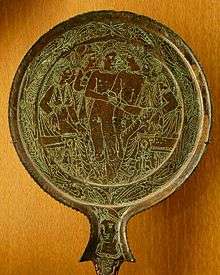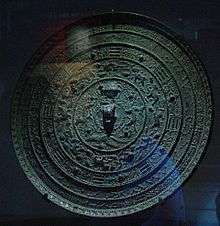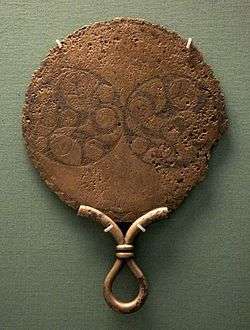Bronze mirror

Bronze mirrors preceded the glass mirrors of today. This type of mirror has been found by archaeologists among elite assemblages from various cultures, from Etruscan Italy to China.
History

Egypt
Polished bronze or copper mirrors were made by the Egyptians from 2900 BCE onwards.[1]
Indus valley civilization
In the Indus valley civilization, manufacture of bronze mirrors goes back to the time between 2800 and 2500 BCE.[2] Bronze mirror are usually circular.
China

Bronze mirrors were produced in China from neolithic times until the Qing Dynasty, when western glass mirrors were brought to China. Bronze mirrors were usually circular, with one side polished bright, to give a reflection, and the reverse side with designs. They often had a knob in the center so that they could be attached to clothing. Some of the earliest examples of Chinese bronze mirrors belonged to the Neolithic Qijia culture from around 2000 BCE. However, until Warring States times, bronze mirrors were not common with approximately only twenty having been discovered. During the Warring States period, mirrors became particularly popular. It was during the Han Dynasty, and the introduction of the TLV mirror, that mirrors started to be mass-produced. Both Han and Tang mirrors are considered to be the most technically advanced. Bronze mirrors continued to remain popular up through the Song Dynasty, but then gradually lost their popularity and ceased to be produced after the arrival of Western mirrors during the Ming and Qing dynasties.
Japan
In Japan, a lot of bronze mirrors have been unearthed in the ruins of the tumulus period from Yayoi era. Mirror to be excavated, and Chinese cabbage mirror of imports from the continent, are classified it to HOSEI(仿製) mirror(made in Japan) domestic imitating the (law success). The types, rated chrysanthemum mirror (law Kakuki predicament) and the inner row Hanabunkyo (introvert Kyo Kamon) who excavated from Yayoi ruins of northern Kyushu, triangle edge to be excavated from the keyhole-shaped around the country as the center of the Yamato Kamijuukyo (Sankakubuchishinjukyo), and the like.
Yayoi period ( 300 BC to AD 300 in Japan)
Bronze mirror is the excavated goods that characterize the Yayoi era along with the bronze bell-shaped vessel, bronze mirrors, bronze bell-shaped vessel cultural sphere and the like have been discussed by the distribution.
Mid-term of the Yayoi era, in the northern part of Kyushu, the Western Han Dynasty mirror to jar coffins began to be congestion. Bronze mirror is prized as a treasure device, Han mirror after began to begin to congestion is to late, is Desa cast statements that I put a prayer to longevity, people with the mirror prosperity of longevity and descendants it was that is Yakusa. In addition, anyone rather than be able to own a bronze mirror, it has been limited to such influential people and the priest's. In the Sea of Genkai coastal areas in northern Kyushu, there is a jar coffin was congestion a large number of mirror of even 20 sheets Toka 30 sheets, etc. immediately Okamoto ruins and Mikumo ruins, is seen luxury of the king of the tomb. Customs that congestion a bronze mirror in the tomb, is also taken over by the tumulus era, has spread across the country.
Mirror as grave goods is, in the front during the ... late, was the so-called Han mirror or Han-type mirror, in the end-of-life ancient tomb is in Sui-Tang mirror. However, it is the only format name, it is not actually affected by the Sui and Tang.
Kofun Period ( AD 250 – 538 in Japan )
The excavated example of bronze mirror of Kofun period the previous year, 36 surface of the Tsubai Daizukayama tumulus, 34 surface of the Shinzan tumulus of Nara Koryo-cho, 34 surface of the black tomb [1], about 30 surface of Samita Takarazuka tumulus, Yamato Tenjinyama 23 surface of the tumulus, 22 surface of the Gotabi mountain ancient tomb of Osaka Habikino, 12 side of the purple Mountain tumulus, 30 surface of Heshan tumulus of Okayama Prefecture Bizen, 13 surface of Kurumazuka Bizen, Aichi Prefecture Inuyama of Higashino Palace ancient tomb there are 11 and the like face. This is seen as Wajin peculiar customs that fill with the dead to put a bronze mirror in a coffin. From Sakurai Chausuyama tumulus of Sakurai City, Nara Prefecture has been excavated a large number of pieces of bronze mirror, where the Nara Prefectural Kashiharakokogakukenkyusho was measured three-dimensional debris, it was restored to the 81-screen portion.
Bronze mirror as a faith subject
In Japan, the mirror has been the subject of Shinto faith. As those that appeared in Japanese mythology, there is such as one of Yata no Kagami and day image mirror, Sunday pike mirror of (the three sacred treasures), there is that enshrined in the company in the mirror as the object of worship.
Since the Heian period, was the subject of faith worship to the Buddha statue in the line carved "mirror image" (Kyosan) is actively produced in the mirror, this is "Kakahotoke" was fitted with a statue of a semi-meat carved in copper plate after (over It has evolved to Buddha)
For Shinto, bronze mirror is also a symbol of as a gift from God, it has been worshiped long in many of Japan's shrine.
Europe
In Europe, bronze mirrors from the Bronze Age have been discovered from various places, including Britain and Italy. A notable example includes the Birdlip mirror. Etruscan mirrors were produced from between the 6th and 2nd centuries BCE. Celtic mirrors in Britain were produced up until the Roman conquest.
See also
References
Further reading
- B. Schweig: “Mirrors”, Antiquity, Vol. 15 (1941), pp. 257–268
External links
| Wikimedia Commons has media related to Bronze mirrors. |